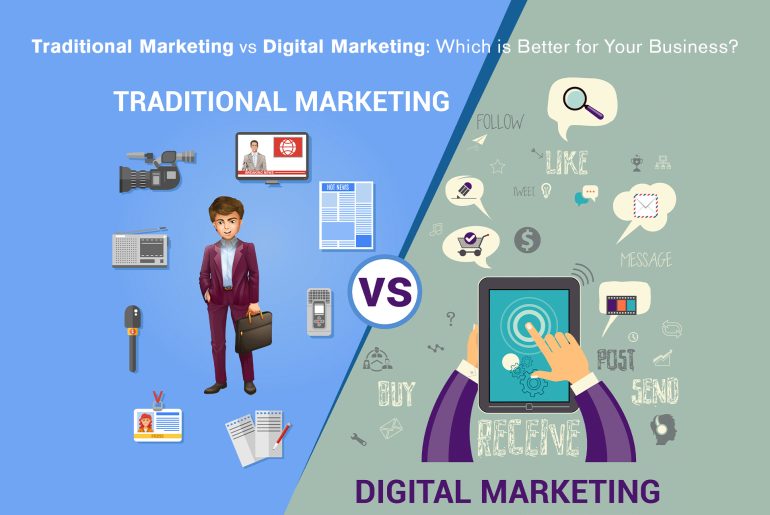Digital marketing has become increasingly popular because it’s easier and more accessible than ever. Despite that convenience, many traditional marketing channels are available to businesses today, including the tried-and-true methods of television and radio advertising. Which one works best? There’s no simple answer to that question, but you can check out some tips to help you decide which type of marketing is right for your business in this guide on digital marketing vs. traditional marketing.
What is Digital Marketing?
Digital marketing includes various strategies and tactics, including search engine optimization (SEO), pay-per-click advertising (PPC), display advertising, email marketing, affiliate marketing, and social media marketing.
Digital Marketing is an umbrella term that encompasses all of these efforts to promote your business online – or any website you’re associated with, for that matter – across multiple channels.
What is Traditional Marketing?
Traditional marketing is any advertising method in which your business’ message is spread through print or broadcast outlets or face-to-face interactions with a customer (e.g., selling your product in person). It includes direct mail, billboards, newspaper and magazine ads, radio and TV spots, outdoor signage, public relations campaigns, etc.
Differences Between: Digital Marketing vs. Traditional Marketing
Many people think digital marketing and traditional marketings are the same. Not so. They’re vastly different. Digital marketing relies heavily on an online presence and mass media to target your market base and reach new customers.
Traditional marketing relies on more personal interactions to ensure message spread. And now that we’ve gone over the differences between digital marketing vs. traditional marketing, it’s time to decide which one works best for your business strategy.
Which type of Marketing should you use?
According to a study of more than 600 marketing executives, 60% of businesses use digital marketing as their primary tool, and 41% of companies use traditional marketing as their primary tool (the remaining ones use both in tandem). So which should you choose? Let’s look at each type of marketing individually before we reach a verdict.
Traditional Marketing: Pros and cons
Traditional marketing refers to that old-school stuff like posters and billboards. Nowadays, most traditional marketers rely on social media optimization (SMO) and search engine optimization (SEO) methods to draw prospective clients in from every possible angle.
Traditional Marketing Pros:
-
Impactful and easy to understand
Digital marketing and traditional marketing both have their benefits and drawbacks. Digital marketing allows you to tailor your message to a specific audience, but it can also be costly; many digital platforms, such as Facebook and Twitter, rely on ad revenue for money and charge high fees to use their services.
-
Printed marketing materials are more permanent
Print marketing materials are more permanent than digital ones, and that’s a significant advantage. For example, if you have a local business and want to advertise your services to people in your area, it makes sense to invest in printed flyers or brochures.
Traditional Marketing Cons:
-
More difficult to measure campaigns
Digital campaigns rely on conversions to measure success, while traditional marketing campaigns are more difficult to measure in terms of ROI. This can make digital advertising riskier and may lead you to abandon your campaign before testing different variations of it on different audiences or targeting specific geographic areas.
-
No direct interaction with the consumer
With traditional marketing, the consumer directly interacts with your product or service—they have to walk into a store, wait on hold to speak with an operator, or sit through an advertisement on television or print. With digital marketing, they don’t have to do any of that—the consumer can be just as easily reached by advertising and interacting online.
Digital Marketing: Pros and cons
Digital marketing offers many benefits over traditional marketing: It’s a faster and more targeted way to reach customers. The ability to better target your audience can lead to increased sales. Cons of digital marketing include that you have less control over your message than with traditional marketing.
Digital Marketing Pros:
-
More options for engagement
When it comes to digital marketing, you have more options for engaging customers than traditional marketing tools.
Offline media relies on one-way communication – something that doesn’t always resonate well with today’s consumers who are used to communicating back and forth via social media.
-
Easy to measure your campaigns
You might be wondering how to measure your digital marketing campaigns and determine whether they’re successful, but luckily it’s much easier to measure your return on investment (ROI) on digital marketing campaigns. You can track how many people click your links and visit a landing page without converting or buying anything online with Google Analytics.
Digital Marketing Cons:
-
Digital ads can be deemed as annoying
Digital ads can be deemed annoying by many people, especially those unfamiliar with their presence on websites and other platforms. Many people dislike pop-ups, pre-roll ads that play before videos, and other forms of interruption marketing like social media ads in their feed or banner ads around a website.
-
Less permanent
Another downside to traditional marketing is that it’s less permanent than digital marketing. You can’t just change your ad copy or repost your images later—it all has to be planned and carried out over an extended period. As such, traditional marketing can be costly in a business context; compared with digital marketing strategies, it’s far easier to measure ROI on online campaigns.
Conclusion:
There’s no one-size-fits-all solution, and both traditional and digital marketing have pros and cons. Choose your strategy wisely, but remember that with each type of marketing, you’ll need to put in some legwork upfront if you want success down the road. And since every business is different, know that it takes a little trial and error to find what works best—but don’t be afraid to try new things!
Frequently Asked Questions
1. Will digital marketing replace traditional marketing?
Many business owners have wondered whether digital marketing will ever replace traditional marketing, but we don’t think it’s necessary to choose one or the other. There are plenty of companies that use both methods successfully. With digital and traditional marketing, you can reach your target audience in different ways and hit them where they are most likely to respond to your message: online, on their phones, or elsewhere.
2. Is traditional marketing still effective?
Of course, it is! Suppose a business has been around long enough to have gained a trusted brand. In that case, there’s no reason why they should stop engaging in practical traditional marketing activities just because their customers are more digitally connected than ever before. Email and direct mail marketing are still some of today’s most effective marketing strategies, but only if executed well.





